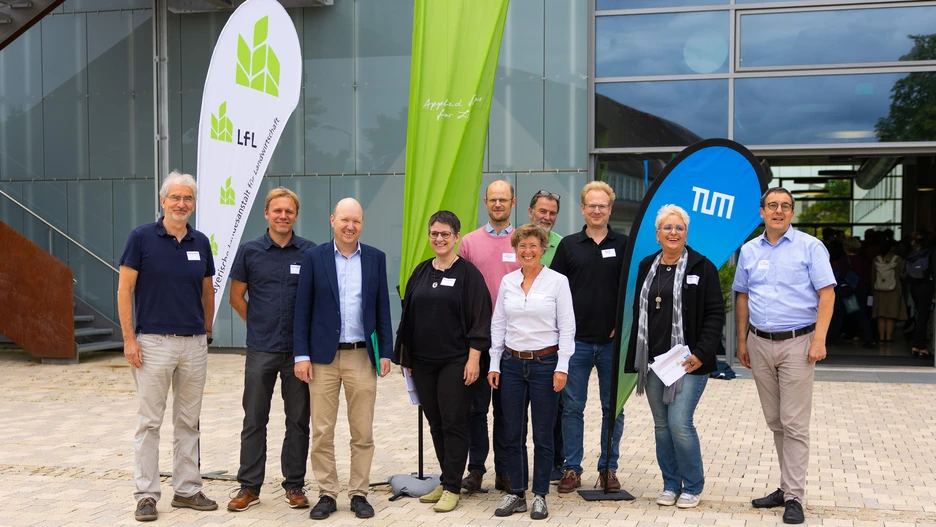Future-oriented cooperation: Show-and-Tell of funded research projects at the AgroMissionHub
Research, Campus, Event |

From left to right: Senthold Asseng (TUM), Martin Wiesmeier (LfL), Christoph Moning (HSWT), Martina Bauer (HSWT), Bernhard Schauberger (HSWT), Annette Freibauer (LfL), Michael Beck (HSWT), Benjamin Schusser (TUM), Claudia Luksch (TUM), Ralph Hückelhoven (TUM)
Photo: Samira Roll/HSWT
The AgroMissionHub (AMH) is a joint initiative of HSWT, LfL, and TUM that has been promoting innovative research projects at the interface of science and practice in the field of agricultural and horticultural sciences since the end of 2023. In doing so, the AMH strengthens and bundles the cooperation and expertise of the three institutions in a sustainable manner and promotes joint, advanced, and innovative research projects.
Deepening scientific exchange
The event was opened by the steering committee of the AgroMissionHub, represented by Prof. Dr. Christoph Moning, Vice President of Research and Knowledge Transfer at HSWT, Dr. Annette Freibauer, Vice President of Knowledge at LfL, and Prof. Dr. Senthold Asseng, Scientific Director of the Hans Eisenmann Forum and Professor of Digital Agriculture at TUM. In their welcoming remarks, they focused in particular on the AgroMissionHub as a platform for innovation and synergies, emphasizing that the AMH has given rise to cross-project collaborations that specifically link existing expertise and further develop joint research approaches.
Presentation of eight future-oriented research projects
Die trilateralen, geförderten Projekte, die im Rahmen der Veranstaltung vorgestellt wurden, decken ein breites thematisches Spektrum ab. Die Fachrichtungen reichen von Robotics (AMAIzed), insect biodiversity (APART), greenland biodiversity (BioBayGrün) and Carbon storage and grassland ecosystems (Grazing/Grassland BGD) to pathogen resistence in crops (GWECAs), nitrogen cycles in the soil (NEOM) as well as vertical farming of pharmaceutical plants (VerticalPharm) or the conceptualization of an innovation and research facility (Labor- und Versuchsstation Veitshof).
Scientific added value and structural effects
The development of joint infrastructures creates a sustainable foundation for future cooperation. Within the framework of the GWECAs and Grazing projects, joint follow-up projects were successfully applied for and new partners were integrated. The NEOM project successfully used the data obtained in the AMH context for a DFG follow-up application. The AMAIzed, APART, and VerticalPharm projects also build on the cooperation basis created in the AMH and serve as a starting point for further third-party funding applications.
Landmark merger
The AgroMissionHub's show and tell demonstrates that the research projects benefit from the merger of the institutions on several levels, from complementary expertise in agricultural sciences to access to established networks and the shared use of research facilities. Stephan Sedlmayer, President of the LfL, was enthusiastic about the results of the collaboration: “The AgroMissionHub's show-and-tell event clearly demonstrated that cooperation between the three institutions, TUM, HSWT, and LfL, works well in Weihenstephan on an equal footing. You could really sense that the researchers, in their respective roles, are keen to work together and can deliver excellent results.” Hubert Heigl, President of Naturland - Verband für ökologischen Landbau e. V., was also impressed by the results of the research projects: “The research projects show how well the three institutions can work together! When the scientific questions of the individual institutions are linked to the requirements of practice, great things can happen.”
Informative exchange between researchers and interested parties
Finally, the get-together and networking event offered all participants the opportunity to discuss the individual projects, clarify individual questions, and register their interest in potential future projects.